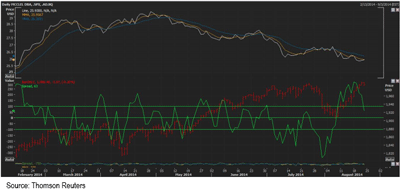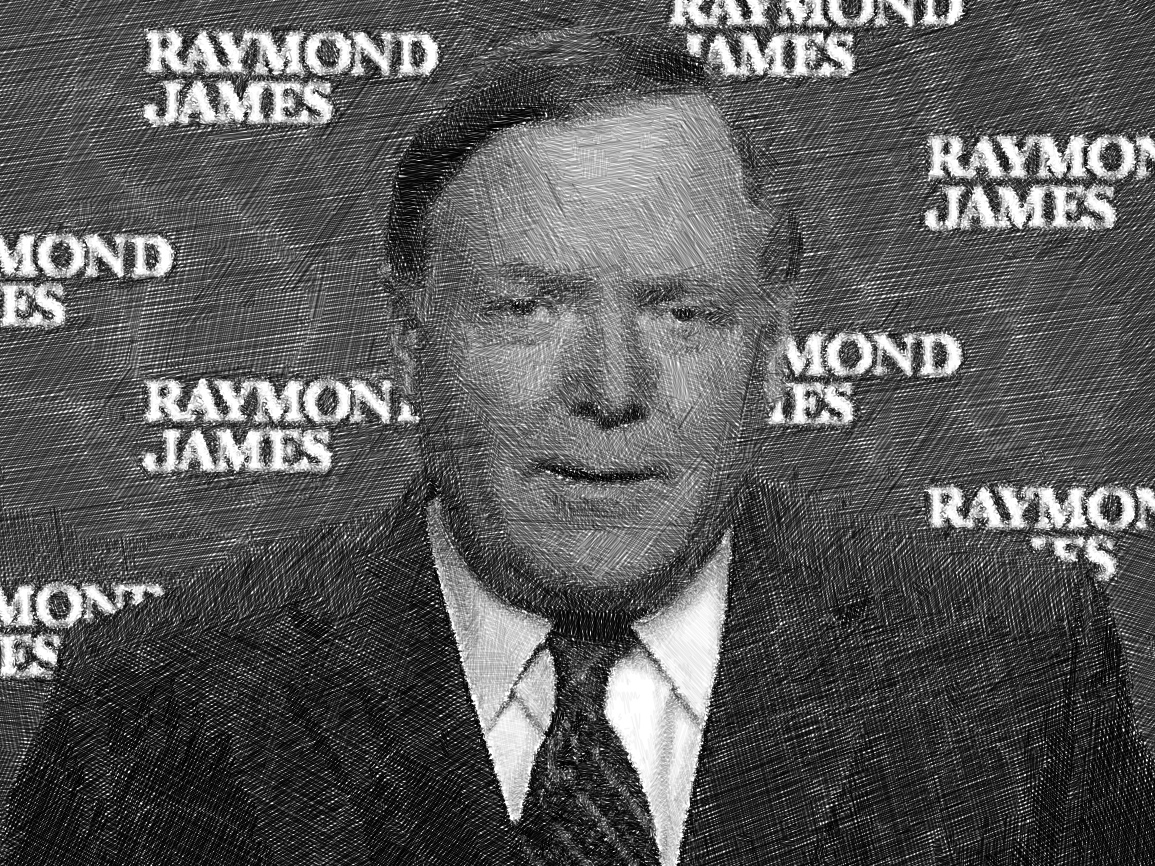“Being Right or Making Money”
by Jeffrey Saut, Chief Investment Strategist, Raymond James
August 25, 2014
“Apparently, Barry Bannister has raised his 12-month S&P 500 price target from the lowest on the Street to the highest price target, an increase of 450 S&P points in his forecast from 1850 to 2300. Bannister was, not surprisingly, self-confident in view. [However] never did I hear the words, ‘I was wrong, or I don’t know.’”
... Doug Kass, Seabreeze Partners
So wrote my friend Dougie Kass in his blog of last Friday referencing Stifel Nicolaus’ strategist Barry Bannister. Now I grew up sailing on the Chesapeake Bay and one of the old watermen’s axioms is, “You can’t change the direction of the wind, but you can adjust the sails!” As with sailing, you can adjust your “sails” in the stock market because if you do not adjust for the changing causal relationships you are doomed. Hence, I have no trouble with Barry Banister adjusting his price target. However, like Doug, I find it disingenuous that there is no mention of being wrong. As Doug further scribes, “When I am wrong, I try to say/write that I have been wrong (as I have been on my market call this year). When I don't know, I say it. I have learned to never be self-confident in view and to worry about what or who lies over my shoulder (especially of a Cossack kind!). As Grandma Koufax used to say, ‘Dougie, honesty is the best (insurance) policy’.” Doug’s prose reminds me of another Wall Street icon, namely Peter L. Bernstein, who wrote:
After 28 years at this post, and 22 years before this in money management, I can sum up whatever wisdom I have accumulated this way: The trick is not to be the hottest stock-picker, the winning forecaster, or the developer of the neatest model; such victories are transient. The trick is to survive. Performing that trick requires a strong stomach for being wrong, because we are all going to be wrong more often than we expect. The future is not ours to know. But it helps to know that being wrong is inevitable and normal, not some terrible tragedy, not some awful failing in reasoning, not even bad luck in most instances. Being wrong comes with the franchise of an activity whose outcome depends on an unknown future (maybe the real trick is persuading clients of that inexorable truth). Look around at the long-term survivors at this business and think of the much larger number of colorful characters who were once in the headlines, but who have since disappeared from the scene.
As stated in previous missives, I am wrong, and wrong a lot, but being wrong comes with the franchise of an activity whose outcome depends on an unknown future. My redeeming feature is that I am unafraid to admit to being wrong. As well, when I am wrong I am usually wrong quickly and for a de minimis loss of capital. Case in point, around the beginning of July, for a plethora of reasons chronicled in these reports, I began looking for a pullback. As events unfolded it felt more and more like we were finally going to get the 10% - 12% decline the historical odds call for some time this year. Indeed, first the S&P 500 (SPX/1988.40) broke below the 1940 – 1950 support, bringing into view the secondary support zone of 1890 – 1900. But as we approached that 1890 – 1900 zone the decline was arrested by some encouraging geopolitical news; and when the SPX traveled above the now 1940 – 1950 overhead resistance zones, I had to admit to being wrong and embrace the “call” of testing the highs and maybe more.
At the time I suggested three potential trading patterns. First, the SPX rallies up to either its all-time closing high of 1987.98, or its all-time intraday high of 1991.39, and then fails to make a higher high, leading a pullback attempt. Second, the SPX rallies slightly above its all-time highs with a peak-a-boo “look” to new highs enough to get everyone excited about another new leg to the upside just in time to get a pullback. That would be the reciprocal pattern of the bottoming sequence that saw a peak-a-boo “look” to new lows on October 4, 2011. At the time I was comparing that pattern with the similar patterns of 1978 and 1979 that saw those “undercut lows” end the decline, which is why we were bullish on October 4, 2011. As a sidebar, I continue to believe that was the “valuation low” launching this current bull market, not the “nominal price low” of March 2009. The third scenario is that this is for real and we are set for another leg up in the ongoing secular bull market. And to that secular bull market theme, while I have been wrong a number of times on the magnitude of various pullbacks, I have never wavered on the fact that I think we are into a bull market. In the attendant chart (chart 1) the nominal price lows of December 1974 and March 2009 are delineated by the blue arrow. Worth noting is that nobody measures the 1982 to 2000 secular bull market from the December 1974 low, but rather the valuation low of August 1982. When you measure this bull market from its respective “valuation low” of October 4, 2011, it is not nearly as long-of-tooth as the bears would have you believe.
Given last week’s action obviously the first negative scenario has been eliminated. This week should tell us if this is just a peak-a-boo “look” to new highs, or something more. Surprising, at least to me, is that the 11-session straight-up move has not resulted in a massively overbought condition in the NYSE McClellan Oscillator (chart 2). It also begs the question, “Are we in a buying stampede?” Recall “buying stampedes” tend to last 17 to 25 sessions, with only one- to three-session pauses/pullbacks before they exhaust themselves on the upside. Hereto, this week should tell us if this is a stampede. If it is, today is session 12. However, I am still worried about the topping formation coincident with the 64-65-66 month sequence often referenced in these missives that has “topped” a number of rallies. This month is month 65.
This morning worries about the “humanitarian aid” from Russian convoys, Chinese jets dangerously close to our surveillance planes, Iceland’s volcano, and the earthquake in Napa Valley are being offset by hints of further monetary easing by the ECB, more Monday merger mania, and better geopolitical events. The result has left the 5-year to 30-year U.S. yield curve the flattest it has been since the 2008 financial crisis, so the bond market is worried about something. Stock pickers at the Bank of Montreal, however, are betting on improving growth in the U.S., and a decline in the euro currency, which should be bullish for U.S. equities. I agree and continue to believe we are in a secular bull market that has years left to run.
The call for this week: The title of this report is “Being Right or Making Money,” which is the title of a book by Ned Davis that resides on my desk. I would certainly rather make money than “be right!” But, “Being wrong comes with the franchise of an activity whose outcome depends on an unknown future.” So yeah, I was wrong and all we got was yet another ~5% decline. But, again I wasn’t wrong for long because when the SPX broke above the 1940 – 1950 overhead resistance zone I said we were going for the all-time highs; and here we are with the preopening futures up by 6 points at 4:30 a.m. Meanwhile the U.S. dollar is sharply higher on Kuroda and Draghi’s dovish comments and don’t look now but gasoline has declined from ~$3.30 per gallon to $2.70 basis the futures market. That is obviously consumer friendly, which is why the Consumer Discretionary sector was up by more than 2% last week. Indeed, last week the equity markets seemed to be driven by better economic news (existing home sales +2.4%, building permits +8.1%, housing starts +15.7%, LEI +0.9%, Philly Fed 28.0, etc.). To the Philly Fed report, I don’t understand (there’s that phrase again) how a 3.5 pop in Inventories and a 0.8 rise in the Average Workweek offset declines in seven other components (see chart 3).
Chart 1

Click here to enlarge
Chart 2

Click here to enlarge















